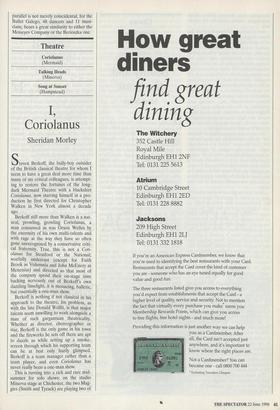Dance
Celtic roots
Giannandrea Poesio
Amuch as I love folk-dances from all over the world, I have always had some reservations regarding what is commonly and erroneously considered as the 'only' form of Spanish dancing, namely flamenco. Intoxicating as it might be, especially when performed by dancers from either the Anto- nio Gades company or the Cumbre Flamen- ca, flamenco dancing can also become rather boring and repetitive once the first ten to 15 minutes are over. After all, that particular choreographic genre rests on a set of only seven dances — Alegrias, Soleares, Bulerias, Farruca, Zapateado, Tango and Zambra which, at the end of the day, does not ensure a great deal of variety, in spite of all possible combinations.
I am grateful, therefore, to the Ballet Galego Rey de Viana for making me dis- cover that there is more to Spanish dancing than machine-gun-like stamping feet, intense looks and voluptuous inward move- ments. The strength of the Ballet Galego is a vast, varied repertoire of dances from the northern region of Galicia, which does not have much in common with the stereotypi- cal tourist's notion of Spanish dancing. A striking element is, in fact, the great deal of Celtic influence to be found in the move- ment vocabulary (according to some histo- rians, Galicia was one of the places in mainland Europe where the Celtic lan- guage was spoken before and during the Roman period); many choreographic com- binations bear thus a considerable and astonishing similarity to some Scottish dances — they are even accompanied by hornpipes — or Irish ones, such as those recently popularised by Riverdance.
Created in 1949, the Ballet Galego has always striven to preserve the multifaceted, choreographic traditions of the region it comes from and to make this cultural patri- mony available to a greater public. To turn folk-dancing into a theatre genre is always a risky enterprise, for the stage require- ments may affect both the patterns and the composition of the dance intended origi- nally for different public spaces such as squares or ballrooms. In addition, some spectacular components of folk-dancing might not result as such once on stage, thus rendering the dance theatrically unappeal- ing and flat. Still, the late Jose Manuel Rey de Viana, founder of the company, and his wife Victoria Canedo, current director and dance-master, have devised a particular choreographic approach to each dance that neither vitiates nor alters considerably their original nature, assuring, at the same time, a good dose of enjoyable theatrical enter- tainment.
In most cases, the dancing develops with- in a given theatrical situation that contextu- alises and justifies the choreography, thus allowing a further understanding of both the meaning and the purposes of the dance itself. The programme, moreover, is struc- tured so that each choreographic item does not constitute a close number, but is some- how linked to both the previous and the subsequent ones. There is, therefore, a sort of narrative quality which permeates the entire performance. The various images, now happy and joyful, now intensely sad and lyrical, flow, showing different aspects of Galician life in different epochs and in different moments of the year. Most of the dances are of the 18th-century, and there is a surprising amount of refined, yet grand- baroque, courtly mannerism — the same that is found in the early days of classical ballet — echoed in the stunning costumes, accurately reconstructed from primary visual sources. There is also a great deal of pleasant naivety that mirrors the simple principles of the less grand rural environ- ment from which some of the dances origi- nated. The tools used to carve the stone provide the rhythm for a dance, as do the wooden soles of traditional local boots.
Superstition and religion go happily hand in hand, and a priest, leading a procession on stage, blesses the peasants just before they launch themselves into a dazzling sequence of Muneira, Fandango e iota; black magic rituals are exorcised by danc- ing to the accompaniment of the pandeiro, a percussion instrument, but at the end the exorcising dance becomes furious and almost orgiastic. Quick footwork, energetic jumping and intricate patterning seem to be the three distinctive traits of these dances. Elegance is also a key element, particularly evident in the all-female dances such as Danzade or Belidas Filan- deiras where the performers glide on stage, not unlike their Russian counterparts. The parallel is not merely coincidental, for the Ballet Galego, 48 dancers and 11 musi- cians, bears a great similarity to either the Moiseyev Company or the Berioszka one.



























































 Previous page
Previous page